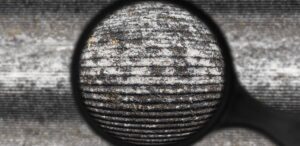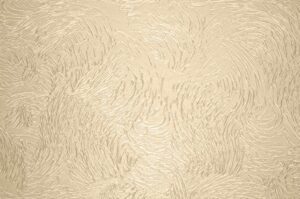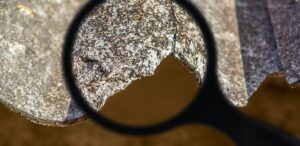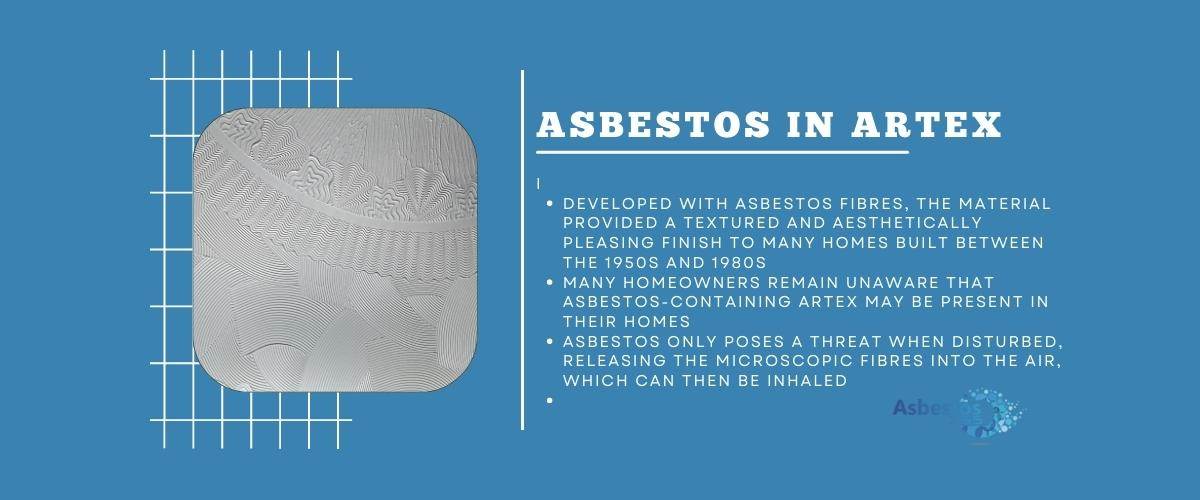
Asbestos in Artex
In recent years, the use of asbestos in Artex has become a growing concern. As you may be aware, Artex is a popular decorative coating used throughout the UK for walls and ceilings. Developed with asbestos fibres, the material provided a textured and aesthetically pleasing finish to many homes built between the 1950s and 1980s. However, the harmful effects of asbestos exposure have since come to light, and it’s essential to understand the risks involved with having Artex in your home.
Many homeowners remain unaware that asbestos-containing Artex may be present in their homes, and as a result, they could unknowingly expose themselves to hazardous material resulting in serious health risks. However, it is crucial to note that, in most cases, asbestos only poses a threat when disturbed, releasing the microscopic fibres into the air, which can then be inhaled. Thus, it is essential to approach any home improvement projects with caution and proper knowledge.
To ensure your safety and that of your family, it is vital to take necessary precautions and determine whether the Artex in your home contains asbestos. Professional testing and, if required, safe removal should be carried out by experienced and licensed specialists, adhering to UK regulations. In this article, you will become well-informed on the topic of asbestos in Artex, enabling you to make the right decisions for your home and health, and avoid any unnecessary risks.
Check out our article ‘Domestic Properties: Where Is Asbestos Commonly Found?’


History of Asbestos in Artex
As you delve into the history of asbestos in Artex, you’ll discover that Artex is a white, textured coating used to adorn ceilings and walls. During the 1960s and 1970s, its popularity soared as homeowners and manufacturers alike appreciated the aesthetic value and durability it brought to interior spaces.
Incorporating chrysotile asbestos fibres into Artex formulations became standard practice at that time. Chrysotile, a form of asbestos, was recognised for its insulating and fire-resistant properties, which complemented the textured coatings like Artex.
The manufacturers were well aware of the benefits of asbestos fibres, particularly their ability to enhance the structural integrity, flexibility and longevity of Artex. Consequently, Artex and other textured coatings containing asbestos became widely used and gained favour among decorators and builders.
However, over time, the dangers of asbestos exposure became increasingly apparent, and its use in Artex and other surface coatings was gradually phased out.
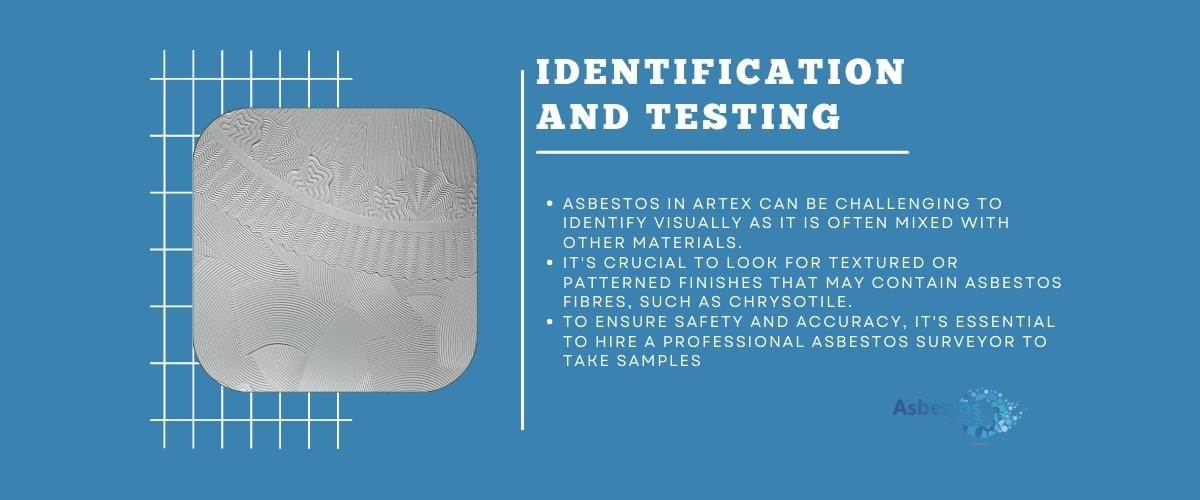

Identification and Testing
Visual Identification
Asbestos in Artex can be challenging to identify visually as it is often mixed with other materials. Keep in mind that Artex containing asbestos was popular in the UK until the mid-1980s, predominantly on ceilings and walls. It’s crucial to look for textured or patterned finishes that may contain asbestos fibres, such as chrysotile. Remember, though, that visual identification is not enough to guarantee the presence of asbestos.
Sampling
To ensure safety and accuracy, it’s essential to hire a professional asbestos surveyor to take samples. Your surveyor will take precautions to prevent disturbance and exposure to asbestos fibres during the sampling process. They will usually:
- Identify the most appropriate area to collect a sample
- Dampen the area to reduce fibre release
- Cut a small section using a sharp tool
- Seal the sample in a labelled container
Laboratory Testing
Once your asbestos surveyor has collected the sample, it will be sent to a testing laboratory for analysis. Accredited testing laboratories will adhere to strict guidelines to ensure accurate results. The methods implemented in labs include:
- Polarised Light Microscopy (PLM): a technique that involves analysing thin sections of the material under a microscope
- Transmission Electron Microscopy (TEM): an advanced analysis method that examines thin samples using a beam of electrons
Results from laboratory testing will determine whether your Artex contains asbestos and if you need to take further action.
While this section has provided an overview of asbestos identification and testing in Artex, it’s by no means definitive. It’s vital to consult with a professional asbestos surveyor and testing laboratory to ensure the safety of your home or workplace.


Health Risks and Effects
As you may know, asbestos is a naturally occurring mineral that was commonly used in various construction materials, including Artex. The primary health concerns associated with asbestos exposure are due to the inhalation of asbestos fibres, which can lead to severe lung diseases.
When you’re dealing with Artex, one of the primary risks of asbestos exposure occurs during drilling activities. Drilling into Artex materials containing asbestos, such as chrysotile, can release asbestos fibres into the air. Therefore, it’s essential to take precautions while working with these materials.
Some of the main health conditions caused by asbestos exposure include:
- Asbestosis: A chronic lung disease caused by the inhalation of asbestos fibres, which leads to scarring of lung tissue and reduced lung function.
- Mesothelioma: A rare form of cancer affecting the lining of the lungs (pleural mesothelioma) or the abdomen (peritoneal mesothelioma). This form of cancer is almost exclusively linked to asbestos exposure.
- Lung cancer: Asbestos exposure increases the risk of developing lung cancer, especially among those who smoke or have a history of smoking.
Keep in mind that the likelihood of developing these health conditions is directly related to the duration and intensity of asbestos exposure. Minimising exposure to asbestos fibres is crucial in reducing your risk of developing these severe health complications.
Check out our article ‘Early Symptoms of Asbestos and What To Do About It’
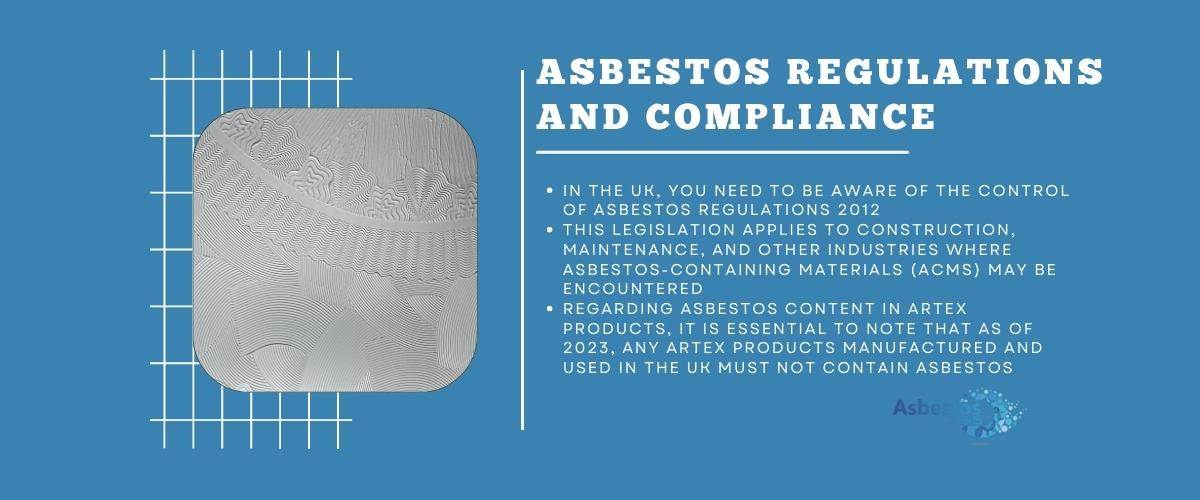

Asbestos Regulations and Compliance
In the United Kingdom, you need to be aware of the Control of Asbestos Regulations 2012, which are designed to protect workers and the public from exposure to asbestos. This legislation applies to construction, maintenance, and other industries where asbestos-containing materials (ACMs) may be encountered.
As a licensed professional, you must follow these regulations:
Licensing: Your company requires an HSE-issued license for any work with higher-risk asbestos-containing materials, such as Artex. Apply for the license and renew it regularly to avoid fines or prosecution.
Identification: Before starting any work, you should carry out a risk assessment to identify the presence of asbestos.
Safe working procedures: You are required to establish a safe system of work, including the use of independent air monitoring. This ensures that employees and the public are not put at risk.
Training: Ensure all employees working with asbestos receive appropriate training. HSE-approved training courses will provide them with the necessary knowledge to work safely and confidently.
Waste disposal: Dispose of asbestos waste safely and in accordance with regulations. You are responsible for packaging, labelling, and transporting waste materials to an appropriate, licensed disposal facility.
Regarding asbestos content in Artex products, it is essential to note that as of 2023, any Artex products manufactured and used in the UK must not contain asbestos.
Following these regulations not only helps protect your employees and the public but also ensures your business remains in compliance with UK law. Maintain a clear documentation trail demonstrating your compliance with the Control of Asbestos Regulations 2012, and seek professional advice for any clarifications to avoid potential legal complications.
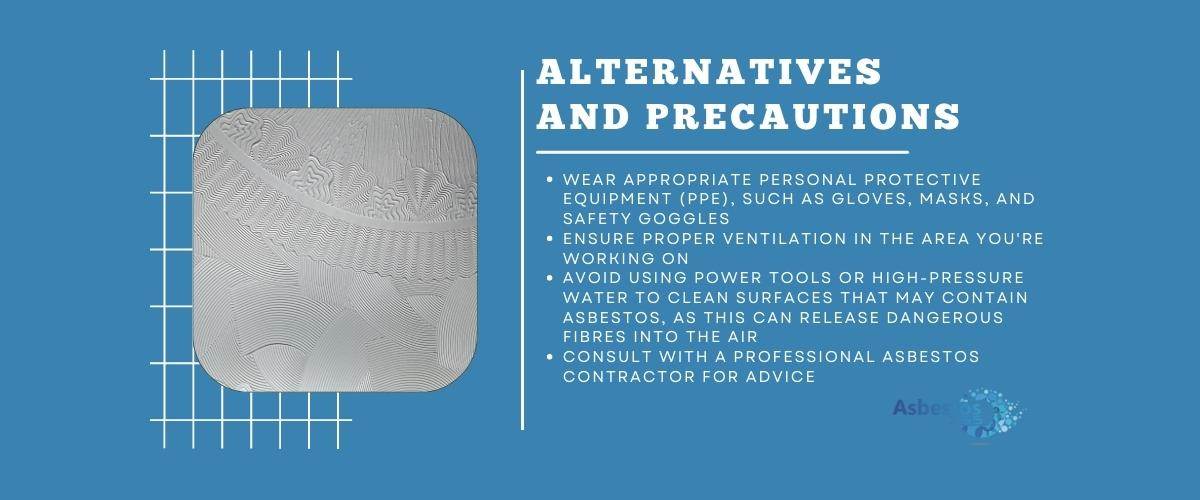

Alternatives and Precautions
When you’re considering interior decorating projects involving Artex or similar textured finishes, it’s essential to use asbestos-free alternatives to avoid the risk of mesothelioma and other health issues related to asbestos exposure. There are several asbestos-free Artex options and decorative finishes available on the market under different trade names which you can safely use in your home.
To achieve various patterns, you can opt for emulsion paint as a safe and effective alternative. Emulsion paint is not only asbestos-free but also offers a wide range of decorative finishes. It can be easily applied using brushes, rollers, or spray-painting to create the desired textures and patterns on your walls and ceilings.
If you’re working on a DIY project involving textured finishes, be sure to take the following precautions:
- Wear appropriate personal protective equipment (PPE), such as gloves, masks, and safety goggles.
- Ensure proper ventilation in the area you’re working on.
- Avoid using power tools or high-pressure water to clean surfaces that may contain asbestos, as this can release dangerous fibres into the air.
- Consult with a professional asbestos contractor for advice on safe handling and disposal of materials containing asbestos.
If you suspect the presence of asbestos in your home, especially in older textured finishes or coatings, it’s essential to have the material tested by a qualified laboratory. Never attempt to remove or disturb asbestos-containing materials (ACMs) without professional assistance to minimise the risk of asbestos exposure.
By using asbestos-free Artex alternatives and taking necessary precautions, you can ensure a safe and visually appealing result for your interior decorating projects.
Asbestos in Artex FAQS
Asbestos is a fibrous material that was commonly used in building materials, including Artex, a decorative textured coating applied to walls and ceilings. In the past, asbestos was added to Artex for its heat-resistant and insulating properties.
No, not all Artex contains asbestos. Since the 1980s, Artex has been reformulated to exclude asbestos. However, Artex in buildings constructed or renovated before this time may still contain asbestos.
You cannot identify asbestos-containing Artex by sight alone. If you suspect your Artex may contain asbestos, it is crucial to have a sample tested by a qualified professional.
If your Artex contains asbestos, it is essential to take the following precautions:
- Do not attempt to remove asbestos-containing materials yourself. Always hire a licensed asbestos removal professional.
- Avoid drilling, sanding or otherwise disturbing asbestos-containing Artex.
- Keep children and pets away from areas containing asbestos.
Asbestos exposure can lead to serious health issues, including lung diseases such as asbestosis, mesothelioma, and lung cancer. However, these risks are generally associated with prolonged exposure or disturbance of asbestos-containing materials. If your Artex is undisturbed and in good condition, the risk of exposure is minimal.
If you accidentally disturb asbestos-containing Artex:
- Leave the area immediately and close all doors and windows.
- Do not disturb further or attempt to clean up the dust yourself.
- Contact a qualified asbestos removal professional to assess the situation and recommend appropriate action.
You can speak to one of our experts on 01923 911013 for advice or testing.





